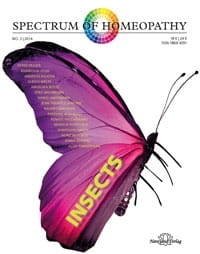Insects - Spectrum of Homeopathy 2014/3
The pace of modern life has increased enormously. Restlessness and concentration problems are the results of a hectic lifestyle. People are disorientated, abandoned and adrift. Material things, external appearances and sexual attractiveness are valued more highly than ethics, empathy, and compassion. We can see all these themes in the homeopathic remedy pictures of insects, as shown by Jonathan Hardy, for example, in the proving and repertory symptoms of the butterfly Limenitis bredowii and the migratory locust Schistocerca.
Even if many new insect remedies have now been well proved, the themes and signature as biological characteristics play a key role in our homeopathic approach to this ancient and most species-rich class of animals. This is also true of well-known remedies such as Apis mellifica, Formica rufa or Coccus cacti in the case histories of Rajan Sankaran, Shekhar Algundgi and Sigrid Lindemann, or Cantharis vesicatoria, known as a bladder remedy, examined by Ulrich Welte. The work with themes and signatures enables initial homeopathic differentiation of the confusing kingdom of the insects. Peter Fraser takes an especially novel approach with his contribution on the feeding habits of the insects. The differentiation between blood-sucking insects, cannibals, plant-eaters, coprophagous (faeces-eating) and nectar-sucking insects produces illuminating insights for homeopathy. This is also true of the parasites, investigated by Jörg Wichmann and Angelika Bolte with the remedies Coccus cacti and Hirudo medicinalis. Ulrich Welte adds additional information on bugs, fleas and other pests. These include the annoying two-winged flies Musca domestica and Culex musca, for which Andreas Richter presents a detailed stress-reaction pattern.
We learn a great deal about butterflies from the informative articles by Jonathan Hardy, Mike Keszler, Alize Timmerman and Jenna Shamat. In addition to their flighty hyperactivity, already investigated by Patricia Le Roux, butterflies are also associated with themes of love and metamorphosis, death and rebirth.
The multifaceted contributions of this issue can only cover part of the unbelievable spectrum of the insect world, which remains terra incognita for homeopathy, in which themes and signatures offer valuable orientation without substituting for new remedy provings. This issue of SPECTRUM seeks to give a feeling for the special energy of the insects and offer encouragement to dive deeper into their kingdom.
- Author: Narayana Verlag
- ISBN: No ISBN
- Paperback
- Published in 2014
- Printed in Germany

